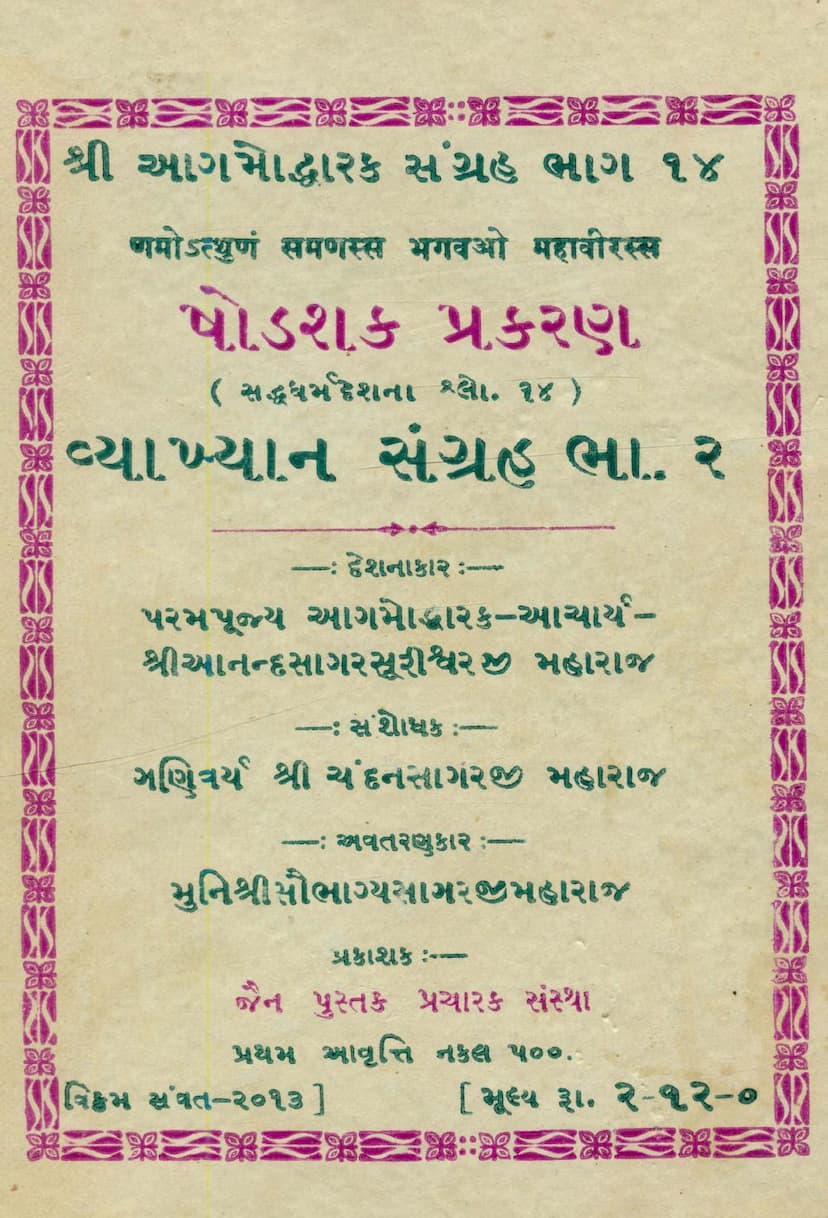Shodashak Prakaran
Added to library: September 2, 2025

Summary
This document is a detailed summary of the Jain text "Shodashak Prakaran" (or "Shodashak Pravachan") by Acharya Shri Anand Sagarsurishwarji Maharaj. The text, compiled by Ganivarya Shri Chandansagarji Maharaj and transcribed by Muni Shri Saubhagyasagarji Maharaj, is presented as a collection of discourses (Vyakhyan Sangrah, Vol. 2). It delves into various philosophical and practical aspects of Jainism, emphasizing the importance of understanding and adhering to the teachings of Tirthankaras.
Here's a breakdown of the key themes and concepts discussed in the text, as reflected in the provided pages:
1. Authoritative Source and Lineage:
- The text is a discourse delivered by Param Pujya Agmoddharak-Acharya Shri Anand Sagarsurishwarji Maharaj, a prominent Jain spiritual leader.
- The compilation and research were done by Ganivarya Shri Chandansagarji Maharaj and Muni Shri Saubhagyasagarji Maharaj, respectively, indicating a strong lineage of scholars and monks.
- The text is part of the "Shri Agaddharak Sangrah," further establishing its place within a larger body of Jain literature.
2. Core Jain Principles and Concepts:
- Vachanaradhana (Adoration of the Word/Teachings): This is a recurring theme, highlighting the central importance of following the teachings of the Tirthankaras. The text repeatedly stresses that true dharma lies in the adoration and practice of these words.
- The Nature of Reality (Jiva and Pudgala): The text distinguishes between the soul (Jiva) and matter (Pudgala), explaining their distinct characteristics and interactions. It emphasizes that the soul is eternal and distinct from the material body.
- Karma and Liberation: Jain philosophy's core concept of karma, its binding nature, and the path to liberation (Moksha) through righteous conduct, knowledge, and faith are discussed. The text explains how karma influences one's state and destiny.
- Dharma, Guru, and Dev: The text scrutinizes the understanding of Dharma, Guru, and Dev. It posits that true understanding of these concepts comes from the Tirthankaras' teachings and not merely from external rituals or blind faith. The true Guru is one who embodies the teachings and guides towards liberation.
- The Soul's Journey (Bhav-Bhavantar): The text touches upon the soul's transmigration through various life forms, emphasizing the rarity of human birth and the importance of utilizing it for spiritual progress.
- Righteous Conduct and Practices: Various ethical principles and practices, such as non-violence (Ahimsa), truthfulness, non-possession, and control of senses and passions (Kashay), are implicitly or explicitly discussed as crucial for spiritual advancement.
- Discrimination and Righteous Understanding: The text stresses the importance of discerning the true nature of things, distinguishing between the eternal (soul) and the transient (matter), and understanding the Tirthankaras' teachings through wisdom and critical evaluation.
- The Role of Faith and Reason: While faith is essential, the text also implies the importance of understanding and reasoning based on scriptural authority (Agam).
- The Nature of Ignorance and Delusion: The text identifies ignorance (Mithyatva) and attachment (Raga-dwesha) as root causes of suffering and bondage, and the path to liberation involves overcoming these.
- The Tirthankaras' Example: The lives and teachings of Tirthankaras, particularly Lord Mahavir, are often used as examples of supreme detachment, spiritual attainment, and compassion, guiding the path to Moksha.
- The Importance of Discernment: The text repeatedly emphasizes the need for careful discernment when evaluating teachings, gurus, and deities, distinguishing the true from the false.
3. Philosophical Debates and Critiques:
- The Concept of Ishvara (God): The text engages with the concept of Ishvara, particularly contrasting the Jain view of the universe's self-originating nature (Pudgala's inherent qualities) with theistic views that posit a creator God. It argues against an anthropomorphic creator and emphasizes the soul's own agency.
- Critique of Other Religions/Philosophies: The text implicitly or explicitly critiques certain aspects of other religious or philosophical systems, particularly those that rely on external deities for salvation or have different interpretations of core spiritual principles.
- The Role of Scripture and Tradition: The text underscores that all spiritual understanding ultimately stems from authoritative scriptures (Agams), and the interpretation and practice of these scriptures are vital.
4. Emphasis on Right Intention and Action:
- The text highlights that mere rituals or external appearances are insufficient for spiritual progress. True devotion and practice stem from a pure intention and a deep understanding of the soul's nature and the path to liberation.
- It distinguishes between actions driven by worldly desires and those motivated by the pursuit of spiritual liberation.
5. The Goal of Moksha (Liberation):
- The ultimate aim of the spiritual path, as outlined in Jainism, is Moksha – the liberation of the soul from the cycle of birth and death and the attainment of its inherent pure and omniscient state.
The "Shodashak Prakaran" appears to be a profound discourse that aims to guide Jain followers toward a deeper understanding and practice of their faith, emphasizing adherence to the Agamic teachings as the path to spiritual realization. The text is rich in philosophical explanations, scriptural references, and practical guidance for spiritual aspirants.